Rating index:
Extraordinary (96-100)
Outstanding (93-95)
Very good to Excellent (89-92)
Above average to Good (86-88)
Below Average to Average (80-85)
Avoid (below 80)
More info >
Extraordinary (96-100)
Outstanding (93-95)
Very good to Excellent (89-92)
Above average to Good (86-88)
Below Average to Average (80-85)
Avoid (below 80)
More info >
Lorenz Adlon (1849-1921) was a powerhouse in the restaurant and hotel scene of the imperial Berlin of Wilhelm II. One might perhaps say that he was the César Ritz of Germany. He was born in Mainz and started his career as a restaurateur in 1877 in the “Raimundigarten” in Mainz. In the 1880’s he moved to Berlin, where he acquired a number of restaurants, the most famous of which was Hiller (Unter den Linden 62/63), one of the foremost watering holes of the German elite at the time. In 1912 he sold it to the Walterspiel brothers. The jewel in his crown however was no doubt Hotel Adlon, which opened in 1907 on the corner of Unter den Linden and the Pariser Platz, a stone’s throw from the Brandenburg Gate. It quickly became the “erste Adresse” in Berlin and counted Czar Nicolas II and King George V among its guests before the Great War, but they also allowed in Thomas Alva Edison, Henry Ford and John D. Rockefeller. It was rumoured that Wilhelm II preferred to stay at the comfortable, modern Adlon, rather than at his imperial palace.
The roaring 1920’s, when Berlin counted among the cultural capitals of Europe, were a heyday for hotel Adlon too; its fortunes during the Nazi rule were mixed. Miraculously, the building survived WWII relatively unscathed, but burnt to the ground soon after the capitulation in 1945. The wing that had remained intact, was destroyed at the orders of the GDR leadership in 1984. After the fall of the Berlin wall on 9 November 1989 a new Hotel Adlon, built on the original site, was opened by the then German president Roman Herzog in 1997. The hotel’s gourmet restaurant Lorenz Adlon Esszimmer (“Lorenz Adlon’s dining room”), with its spectacular views of the Brandenburg Gate and arguably the grandest dining room in the German capital, opened in 1998.
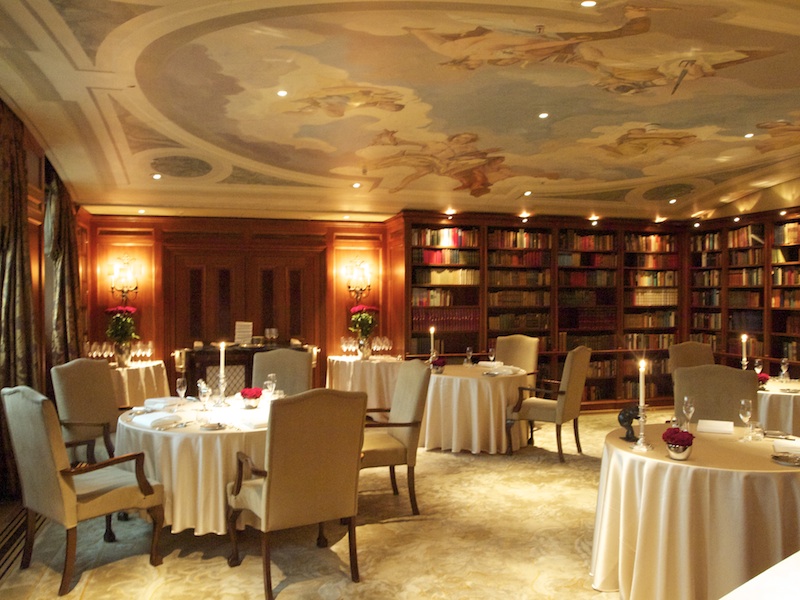
The restaurant was awarded its first Michelin star in 2010 (2011 guide), the second star followed in November 2011 (2012 guide). The man responsible for this recent macaron shower is Hendrik Otto (b. 1974), who has been the chef de cuisine at the Esszimmer since April 2010. His career has been very much what you would expect from a German chef in the premier league: after his training, he worked at Haerlin in Hamburg, Brenner’s Park Hotel in Baden-Baden and Hotel Traube Tonbach in Baiersbronn. He then became head chef in 2002 at La Vision in Cologne (one star) and switched to Vitrum (one star) in Berlin in 2008. Adlon was his next and so far final stop. Front of house is presided over by the suave maitre d’Hôtel Boris Häbel.
Lorenz Adlon Esszimmer is open for dinner Tuesday till Saturday. The restaurant offers an a la carte menu, a 'The Adlon Classics' menu (including Duck à la presse) and there are two tasting menus (menu 1: 4 courses €110, 5 courses €120, 6 courses €130 + menu 2: 6 courses €130, 7 courses €145, 8 courses €160). I had dinner at Lorenz Adlon Esszimmer with my husband on Thursday 30 May 2013 and we both ordered menu 2 (8 courses).
The meal started with four appetisers: (i) 'Toast Hawaii' cylinder with ham crème and pineapple jelly; (ii) beetroot 'snowball' with coriander and grated Parmesan; (iii) shredded lettuce with brown shrimps and puffed rice and (iv) 'Königsberger Klopse', veal aspic on crispy toast with horseradish and grated daikon. Four delicious bites and I loved the elegant and contemporary take on a traditional Königsberger Klopse (veal meatball).

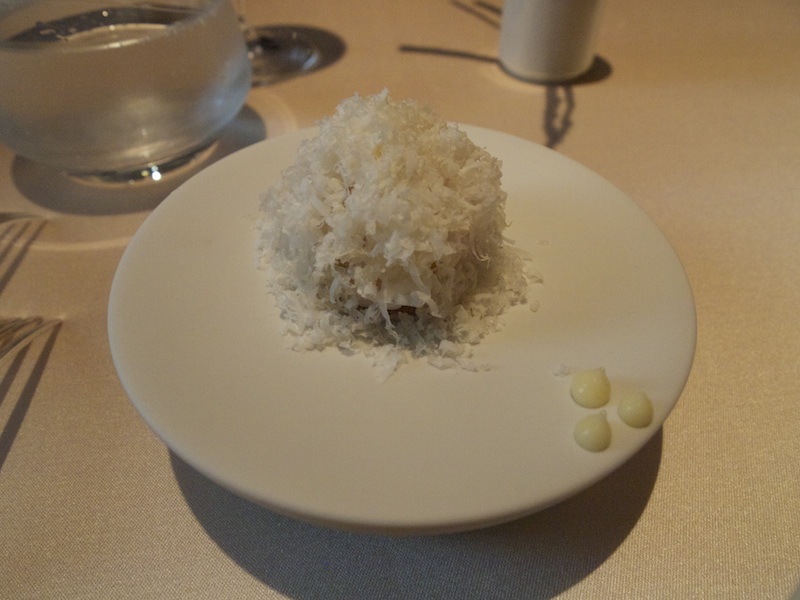
A selection of bread was served with truffle mayonnaise and Obatzda (a mixture of whipped Camembert, butter and paprika).

Next up was an amuse bouche of raw mackerel, cubes of horseradish jelly, puffed rice, avocado crème, coriander cress and soy gel. A lovely combination of fresh flavours with some heat in the aftertaste. With this amuse bouche came a cranberry sour shot with Asian flavoured vodka espuma.
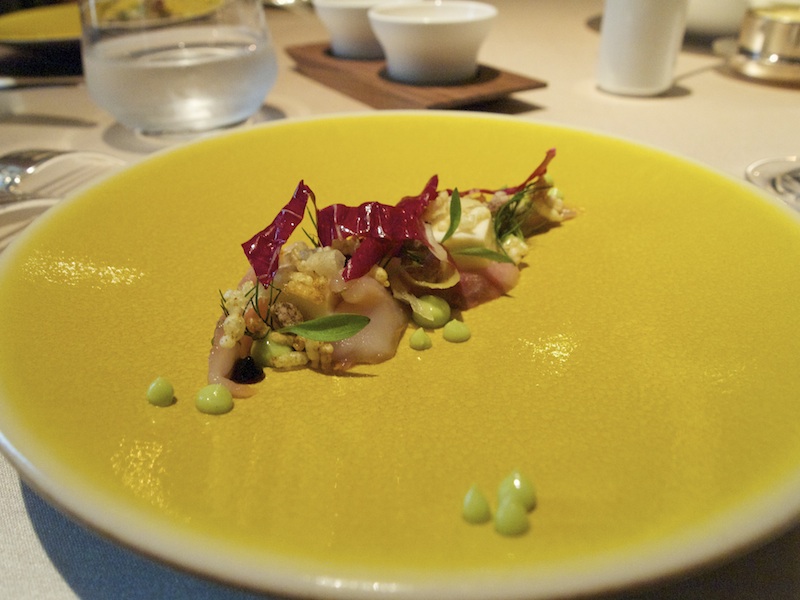
Foie gras was the main ingredient of the first course. The base of the dish was foie gras and almond. Two truffled foie gras bonbons covered with a thin layer of almond jelly, foie gras cubes, iced foie gras parfait, almond jelly spaghetti, almond slivers, almond puree and crisp almond biscuits. Hidden underneath this foie gras and almond extravaganza were a green peppercorn crème and dots of orange zest puree. Some crispy, brioche breaded, polenta cubes were served on the side. The polenta was flavoured with a hint of rosemary, thyme and blue cheese, which added a nice contrast. A complex dish with many flavours but balanced out perfectly by the bitters of the orange zest puree and the green peppercorn crème provided the perfect touch of piquancy. Wonderful textures too, especially the smooth consistency of the truffled foie gras bonbons.
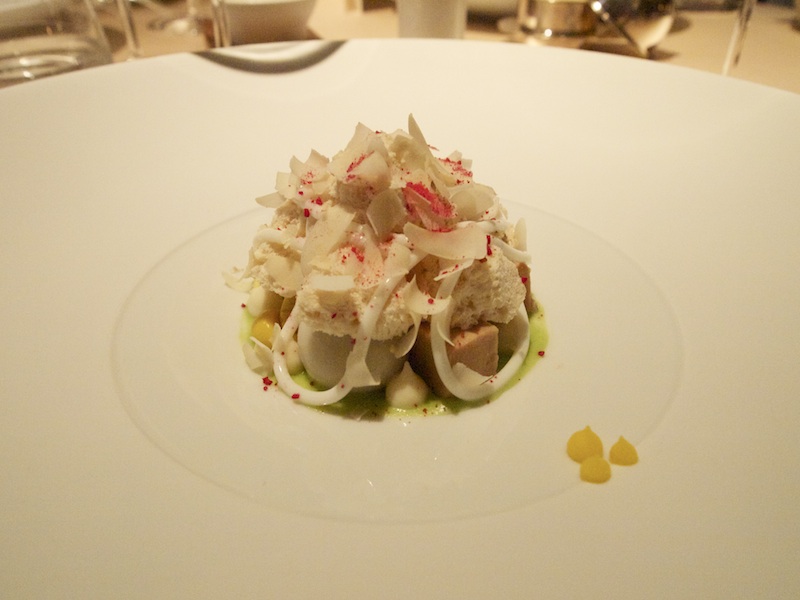
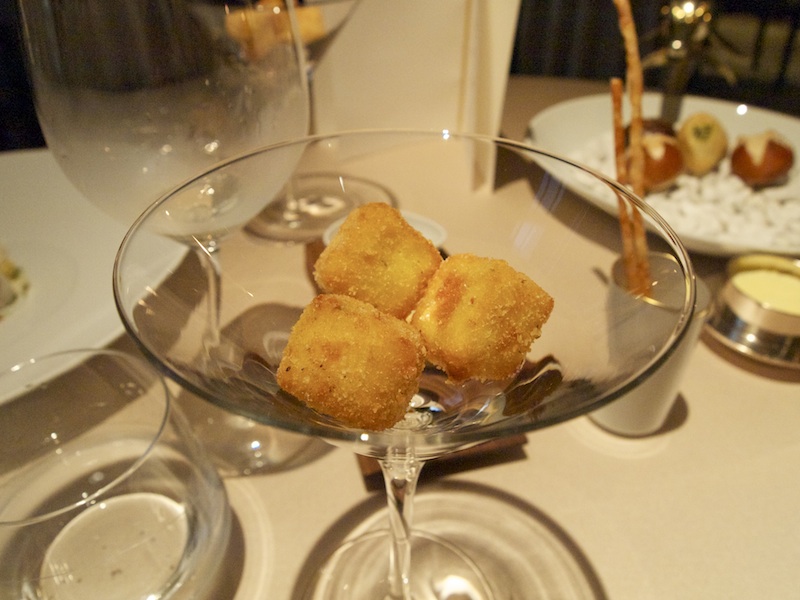
Second course was Langoustine, squid, sauce Dugléré (effectively a reduced fish and tomato velouté), celery, apple, coriander. Perfectly cooked juicy langoustine and a meltingly-soft squid tube with a sublime coconut, lime and lemongrass filling, which had a light consistency and a wonderful creamy finish. Excellent Dugléré sauce which had a great depth of flavour and a hint of paprika. Also on the plate was a celery roll with a fresh apple filling and dots of carrot puree. Some flavoursome, dried little gem leaves were served on the side. A very harmonious and creative dish with a wonderful balance between sweetness and freshness.
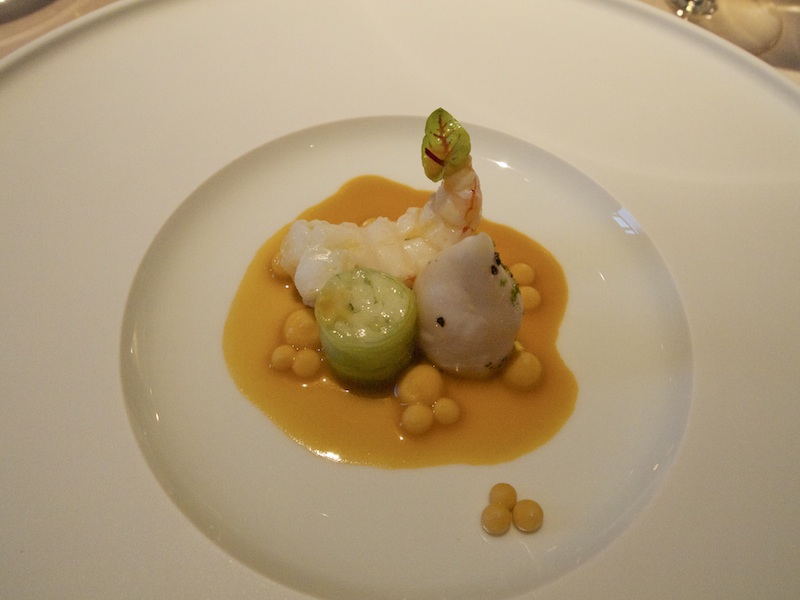
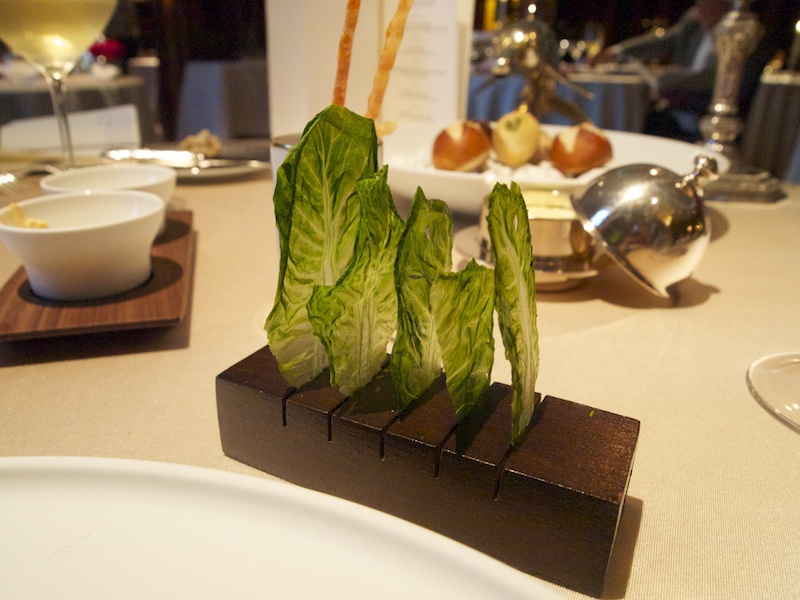
Next to arrive was salmon, beautifully cooked Coho salmon to be precise, served with braised kohlrabi, 'al dente' onions, egg white caviar and a terrific mixture of dried mushrooms, bread crumbs and fresh herbs, which added a wonderful touch of buttery richness. Lovely creaminess and subtle bitters from the delicious onion and celery fumé spooned around the salmon. An elegant and carefully constructed dish with perfectly balanced, rich flavours.

Fourth course: Sardines, artichokes, green olives, red pepper, butter beans, rocket. Pieces of moist sardine, each covered with a thin and crispy bread crust, accompanied by bright red bonbons with an absolutely fantastic, smokey red pepper puree filling, coated in a red pepper gel. The intensity of the flavour of the red pepper puree was amazing. Also on the plate was a wonderfully intense green olive sauce, some black olive crumble, wilted spinach and some delicious butter beans and butter bean foam. A flawless dish with a beautiful interplay of salty, sweet and bitter flavours.
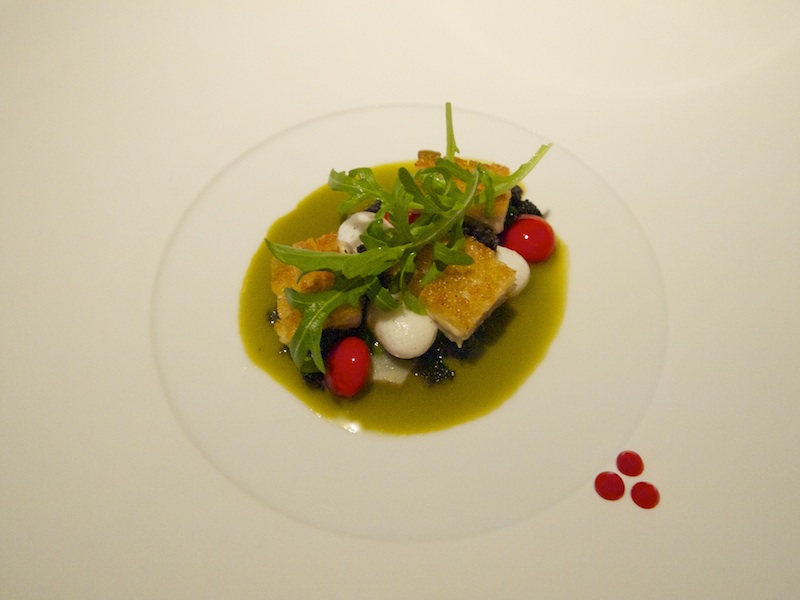
On to the fifth course. Beef, potatoes, corn, goulash jus, braised onions, barbecue onion rings. Gorgeous, soft and tender, braised beef topped with dried corn and herb 'pebbles' and a thin bacon crisp. Next to the braised beef was a delicious, oven baked potato square with a crème fraîche filling. The goulash jus had wonderfully dark and spicy flavours; loved the intensity of the paprika. Hidden underneath the goulash jus were some lovely sweet and soft braised onions. An original dish with powerful but refined flavours. The fried onions rings dusted with barbecue powder were nice and crispy; a quirky touch but for me they didn't add much. Overall however, this was an exceptional dish with great flavours.

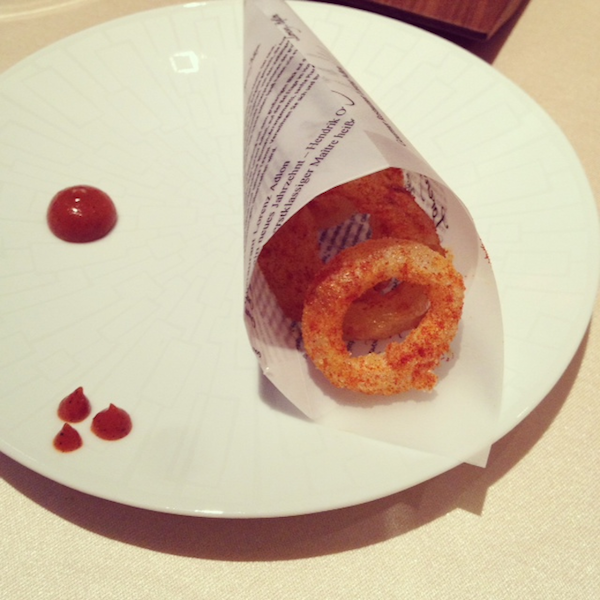
Sixth course was a substantial dish of Chicken, carrot, celery, cucumber ice cream, aubergine puree, mushrooms, tarragon and curry sauce, salted yoghurt cream. Excellent piece of soft and tender chicken with thin layers of mixed herbs, served with a lovely curry and olive oil sauce with swirls of the tarragon sauce. Rich and intense flavours that were balanced by the fresh, salted yoghurt cream and the cucumber ice cream that also delivered a lovely touch of mustardy heat. The leg meat of the chicken had been used to make a crispy, but unfortunately slightly greasy, chicken nugget that was served on the side. A somewhat surprising dish of potato salad topped with a fried egg, was served as another side dish. A lot was going on on the plate, but overall this was a very skilled dish with an unexpected balance of flavours. It could have done without the potato salad however.

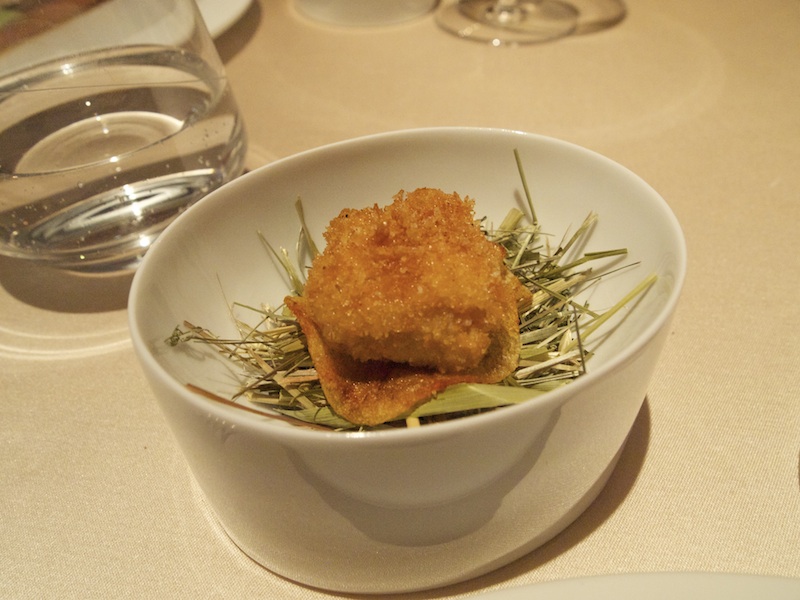
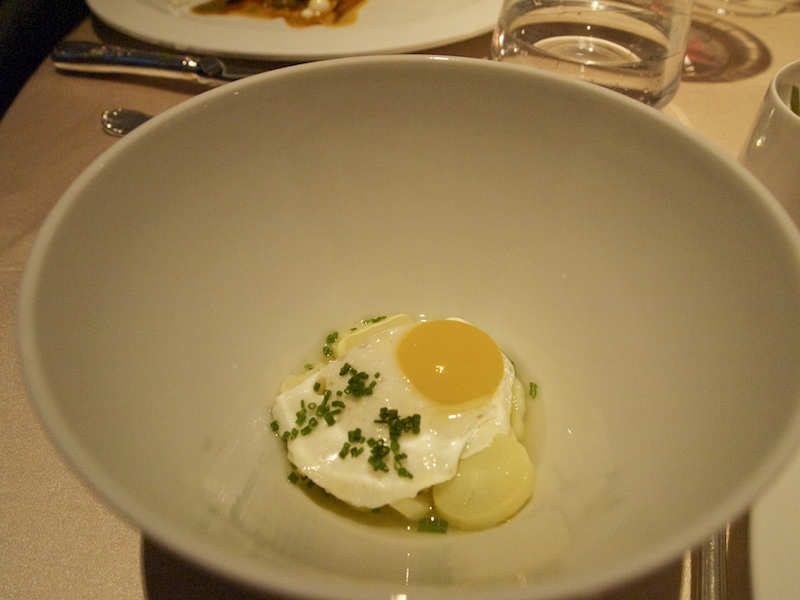
A cheese course was next. Winemaker's cheese, flavoured with Silvaner, served on top of a piece of 'Napfkuchen', a type of bundt cake made with yoghurt and dried fruits. The cheese was covered with a thin sheet of clear jelly and sliced black truffle, and finally a yoghurt espuma, sprinkled with pieces of herb crumble. A lovely and creative cheese dessert.

On to the pre-dessert (no photograph). An elegant and refreshing dessert of hibiscus flower filled with a strawberry sorbet, raspberry crunchies, fresh raspberries and a sorrel mousse.
Final and eighth course was a dessert of buttermilk ice cream, various preparations of rhubarb, 'topfen' (cheesecake), orange puree and poppy seed crumble. Wonderfully fresh and clean-tasting buttermilk ice cream, a creamy rhubarb mousse, rhubarb bonbons with a liquid filling, nice and sharp rhubarb jelly, poached rhubarb and rhubarb ribbons. A bowl with vanilla custard and poached rhubarb was served on the side. A wonderful dessert with a great balance between sharp and sweet flavours.

Since it was reborn some 15 years ago, Hotel Adlon has once again become the "erste Adresse" in Berlin and the aptly named Lorenz Adlon Esszimmer does it proud. Hendrik Otto presents the diner with complex, sometimes almost lavish dishes that are carefully thought out and executed with great skill. The quality of his cuisine, with its elaborate and technically strong style, allows him to turn classic concepts into contemporary dishes that often showcase innovative flavour combinations. The artistic, sometimes even dramatic presentation is not the only indication however that this is ambitious food; the large number of elements occasionally makes for rather busy plates. Sometimes this distracts from the essence of the dishes; leaving out some of the frills might perhaps further improve the focus and precision of the expression. To quote Heston Blumenthal: "part of the art of creating a dish, is knowing where to draw the line" (The Big Fat Duck Cookbook).













